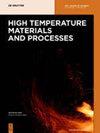Effect of different isothermal times on the microstructure and mechanical properties of high-strength rebar
IF 1.5
4区 材料科学
Q4 MATERIALS SCIENCE, MULTIDISCIPLINARY
引用次数: 0
Abstract
Abstract High-strength rebar plays a supporting role in large engineering structures due to its excellent performance. In this study, the effect of different isothermal time treatments (30, 60, 100, and 200 s) at 650°C on the microstructure transformation and mechanical properties of rebars was investigated. The hot-rolling process was simulated by Gleeble-3800 thermal simulator. The microstructure, precipitates, and mechanical properties of high-strength rebar were characterized by scanning electron microscopy, transmission electron microscopy (TEM), and a universal tensile test machine. Results show that when the isothermal time increased from 30 to 200 s, the ferrite grain size decreased from 10.632 to 8.326 μm, and the pearlite lamellar spacing was refined from 0.230 to 0.142 μm. The TEM confirmed that when the isothermal time increased from 30 to 200 s, the nanoscale (Nb, V, and Ti) C precipitates were uniformly distributed in the ferrite matrix and grain boundary, and the size of precipitates decreased from 34.014 to 29.916 nm; thus, the tensile strength increased from 752.477 to 780.713 MPa, and the yield strength increased from 574.714 to 621.434 MPa.不同等温时间对高强钢筋组织和力学性能的影响
摘要高强度钢筋以其优异的性能在大型工程结构中起着支撑作用。在本研究中,不同等温时间处理(30、60、100和200 s) 研究了650°C温度对钢筋组织转变和力学性能的影响。采用Gleeble-3800热模拟机对热轧过程进行了模拟。通过扫描电子显微镜、透射电子显微镜和万能拉伸试验机对高强度钢筋的微观结构、析出相和力学性能进行了表征。结果表明,当等温时间从30增加到200时 s、 铁素体晶粒尺寸从10.632减小到8.326 μm,珠光体片层间距从0.230细化到0.142 μm。TEM证实,当等温时间从30增加到200时 s、 纳米级(Nb、V和Ti)C沉淀物均匀分布在铁氧体基体和晶界中,沉淀物的尺寸从34.014减小到29.916 nm;因此,抗拉强度从752.477增加到780.713 MPa,屈服强度从574.714提高到621.434 MPa。
本文章由计算机程序翻译,如有差异,请以英文原文为准。
求助全文
约1分钟内获得全文
求助全文
来源期刊

High Temperature Materials and Processes
工程技术-材料科学:综合
CiteScore
2.50
自引率
0.00%
发文量
42
审稿时长
3.9 months
期刊介绍:
High Temperature Materials and Processes offers an international publication forum for new ideas, insights and results related to high-temperature materials and processes in science and technology. The journal publishes original research papers and short communications addressing topics at the forefront of high-temperature materials research including processing of various materials at high temperatures. Occasionally, reviews of a specific topic are included. The journal also publishes special issues featuring ongoing research programs as well as symposia of high-temperature materials and processes, and other related research activities.
Emphasis is placed on the multi-disciplinary nature of high-temperature materials and processes for various materials in a variety of states. Such a nature of the journal will help readers who wish to become acquainted with related subjects by obtaining information of various aspects of high-temperature materials research. The increasing spread of information on these subjects will also help to shed light on relevant topics of high-temperature materials and processes outside of readers’ own core specialties.
 求助内容:
求助内容: 应助结果提醒方式:
应助结果提醒方式:


